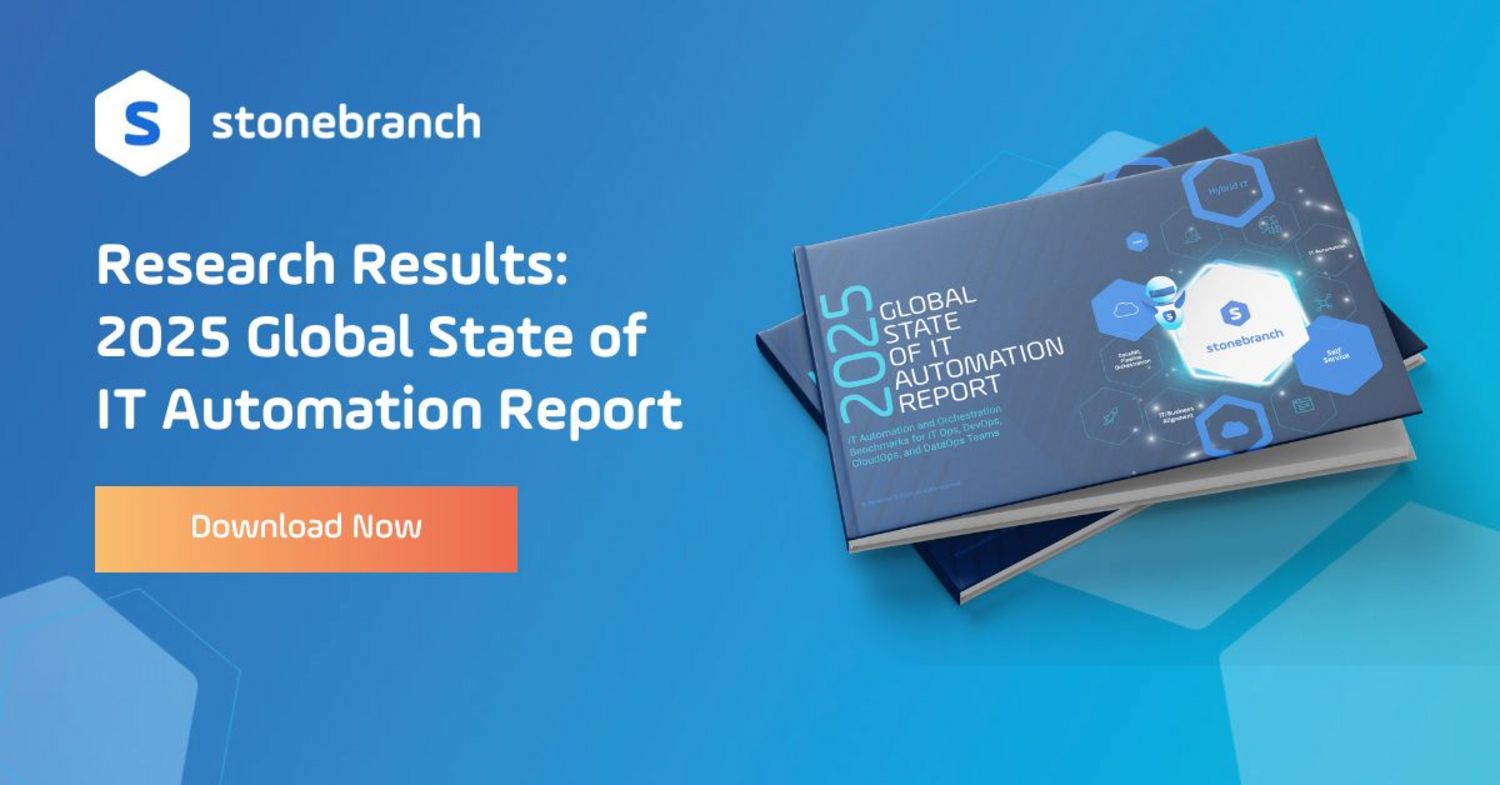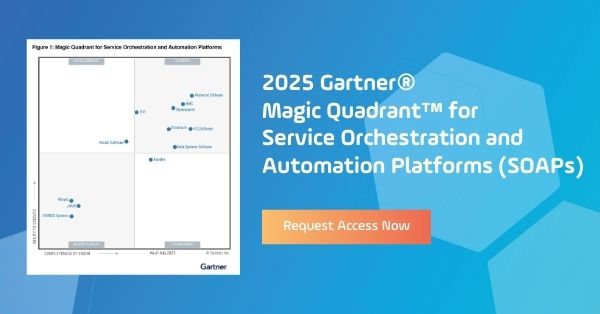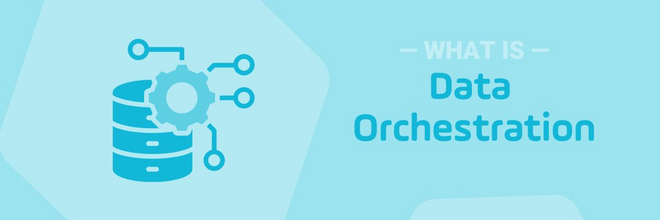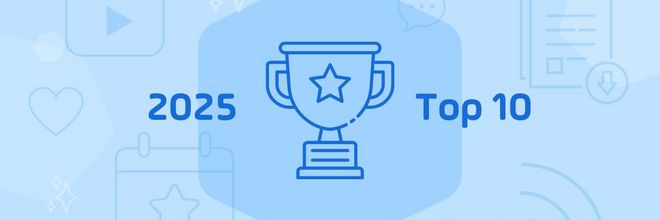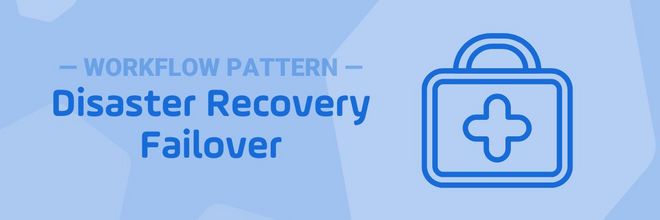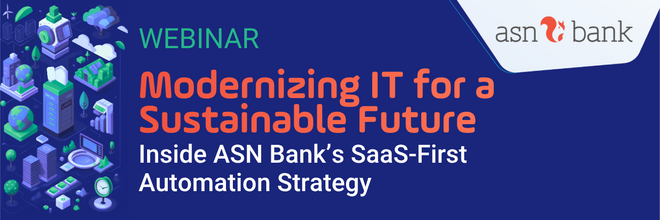Cloud Automation: Tools and Benefits in 2025
Learn which cloud automation tools exist to automate cloud resources, SaaS applications, infrastructure, and security. And finally, learn the benefits of orchestration.
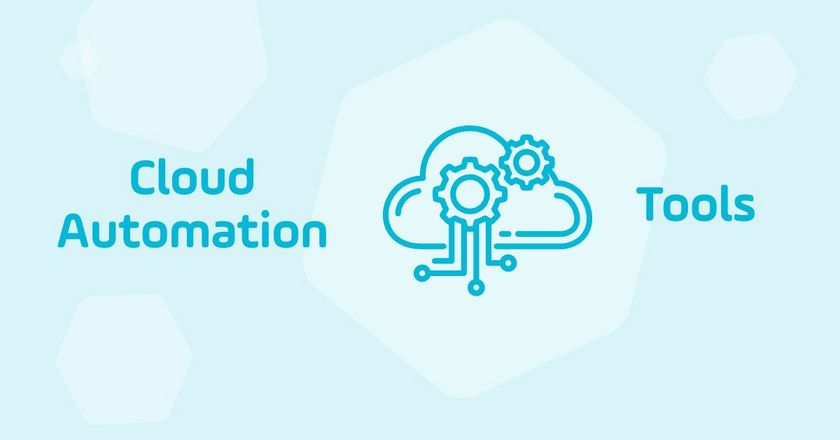
Cloud automation tools eliminate manual IT processes across cloud service providers (CSPs), SaaS applications, infrastructure, and more. As enterprises shift more workloads to the cloud, complexity grows — and with it, the need to automate.
Yesterday’s cloud automation was a patchwork of cloud schedulers and point solutions. Today, it’s about unifying everything under a single service automation and orchestration platform (SOAP).
This article explores the tools behind cloud automation, how to evolve your orchestration strategy, and why a SOAP is essential to successfully manage workflows across multi-cloud, hybrid-cloud, hybrid IT, and on-prem environments.
What Do Cloud Automation Tools Do?
Automation helps untangle complexity. It eliminates repetitive tasks like infrastructure provisioning, environment setup, application scaling, data movement, and policy enforcement so IT teams can focus on higher-value initiatives.
According to the Global State of IT Automation Research Report, cloud-related categories top the chart of applications automated by a service orchestration and automation platform (SOAP) in 2025. CSPs (like AWS, Google Cloud Platform, and Azure) are the most popular, while cloud infrastructure management applications (including Terraform, Chef, and Ansible) follow closely behind.
Why is cloud automation so popular? Because it helps teams work faster, stay flexible, and scale without the usual headaches.
- Speed: Launch best practice infrastructure and services in seconds, not hours.
- Consistency: Reduce human error with repeatable, code-driven deployments.
- Scalability: Automatically adjust resource allocation to match demand.
- Cloud Cost Management: Optimize usage and cloud spend, while reducing manual intervention.
- Security and Compliance: Enforce security policies and apply updates automatically.
- Improved Collaboration: Centralized, transparent workflows make it easier for teams to work together.
Bottom line: cloud automation helps streamline operations and lets IT teams move faster with fewer mistakes.
Leading enterprises already use automation to boost customer experiences, deliver dynamic pricing, and bring innovative offerings to market faster. For organizations serious about agility and growth, cloud automation is no longer a nice-to-have... It’s a must.
Categories of Cloud Automation Tools and Platforms
There are various types of IT automation solutions on the market. Because of its scale, cloud management is only possible when adopting automation processes. With most companies running in a hybrid IT environment, you'll likely need to consider automation that supports managing cloud resources across a hybrid cloud environment.
>Below are examples of cloud automation platforms that help with everything from managing cloud setup and architecture to cost and security.
General Cloud Automation and Orchestration Tools
- Job Schedulers: Most applications have a built-in or native job scheduler. These application-specific tools are limited to automation tasks within their own environment. Typically, job schedulers only support batch or time-based processes and lack the flexibility to interact with external systems.
- Cloud Service Provider (CSP) Schedulers: Major cloud providers offer their own native cloud schedulers. Examples of ways to manage cloud workloads include AWS Lambda and Azure Logic Apps. These tools automate services within their respective ecosystems but don’t extend beyond them. In other words, Azure Logic Apps only works with Azure services.
- Workload Automation (WLA): Some traditional WLA platforms can connect to cloud tools like AWS or Azure services, but their capabilities are often constrained. Built decades ago for mainframes and distributed servers, many on-prem WLA tools struggle to support cloud-native technologies at scale.
- Service Orchestration and Automation Platforms (SOAPs): Evolved from traditional WLA, SOAPs are designed for hybrid IT environments. They orchestrate complex, multi-step business or IT workflows. Notably, SOAP helps to connect the automation dots across on-premises systems, public and private clouds, and containerized workloads. More on this topic will be discussed at the end of this article.
Function-Specific Cloud Tools
While these point solutions play a critical role in managing specific aspects of a cloud operation, they operate within narrow functional boundaries. They often have inbuilt schedulers that rely on batch or time-based triggers. Much like the more general job schedulers discussed in the above section, automation is typically limited to its own environment.
- Cloud Infrastructure Management: Automate provisioning, configuring, and managing cloud infrastructure components like servers and cloud compute like storage, VMs, and networks. These tools often include infrastructure-as-code (IaC), version control, and repeatable provisioning as key features.
- Configuration Management: Oversee and fine-tune cloud resource settings to ensure scalability, consistency, and compliance. These tools support repeatable deployments and adapt easily to changing cloud environments. Typically, configuration management tools automate the setup and ongoing management of servers and applications.
- Cloud Cost and Resource Optimization: Automate monitoring, scaling, and cost optimization across cloud environments. It aggregates information from multiple cloud providers and often recommends the ideal purchasing mix to help control costs.
- Security and Compliance: Manage cloud security posture and ensure compliance with standards. Key functions often include policy-as-code, continuous compliance, and security auditing and alerting.
- Monitoring and Observability: Collect and use log, trace, and metric data from cloud systems for automated analysis and alerting. The data is often aggregated and then visualized for consumption. This category includes a mix of solid open-source and commercial offerings.
- Container Management: Coordinate the deployment, scaling, and administration of containerized applications. It streamlines the complexities of operating containers themselves by simplifying tasks such as launching, stopping, updating, and scaling. Typically, this category of solutions is not designed to automate or schedule the applications running inside containers.
- Backup and Disaster Recovery: Automate tasks like data backup, replication, failover, and fallback. The goal of this type of application is to limit unexpected disruptions and keep systems running smoothly.
Cloud Orchestration — Evolution of Automation
Many enterprises rely on application-specific job schedulers or CSP cloud schedulers in the early days of their cloud transition. Starting with low-cost, easy-to-implement schedulers makes sense during a proof-of-concept stage.
However, as enterprises become more sophisticated, they soon need a centralized orchestrator to transform these siloed processes into end-to-end business workflows. This is the point at which an individual automation turns into an orchestrated process across multiple cloud providers to help create a scalable cloud operation.
To support today’s hybrid environments, cloud orchestration platforms must provide real-time responsiveness, bridge cloud and on-prem environments, unify fragmented tools, and enable citizen automators throughout the organization. Here’s what that looks like in action:
- Real-Time, Event-Based Automation: Event-based triggers launch automation workflows the moment a system event occurs, which eliminates the delays of time-based scheduling. This responsiveness enables a continuous flow of data that moves as fast as your business.
- Orchestrate Across Cloud and On-Prem Environments: Cloud orchestration connects processes across hybrid IT environments, allowing teams to manage workflows that span cloud, on-prem, and containerized systems from a single interface. It also integrates with a wide range of tools — from on-prem systems to specialized apps to any of the cloud automation tools above — bringing disconnected automation efforts under one roof.
- Enable Self-Service Automation: As enterprises continue cloud adoption, it's common for non-technical users to require self-service access. Business users commonly want to launch workflows independently through intuitive portals and integrations with enterprise apps like ServiceNow, Jira, Slack, or Microsoft Teams. This approach has nearly universal appeal — the 2025 Global State of IT Automation report finds that 95% of enterprises now offer self-service automation, up from 84% in 2022.
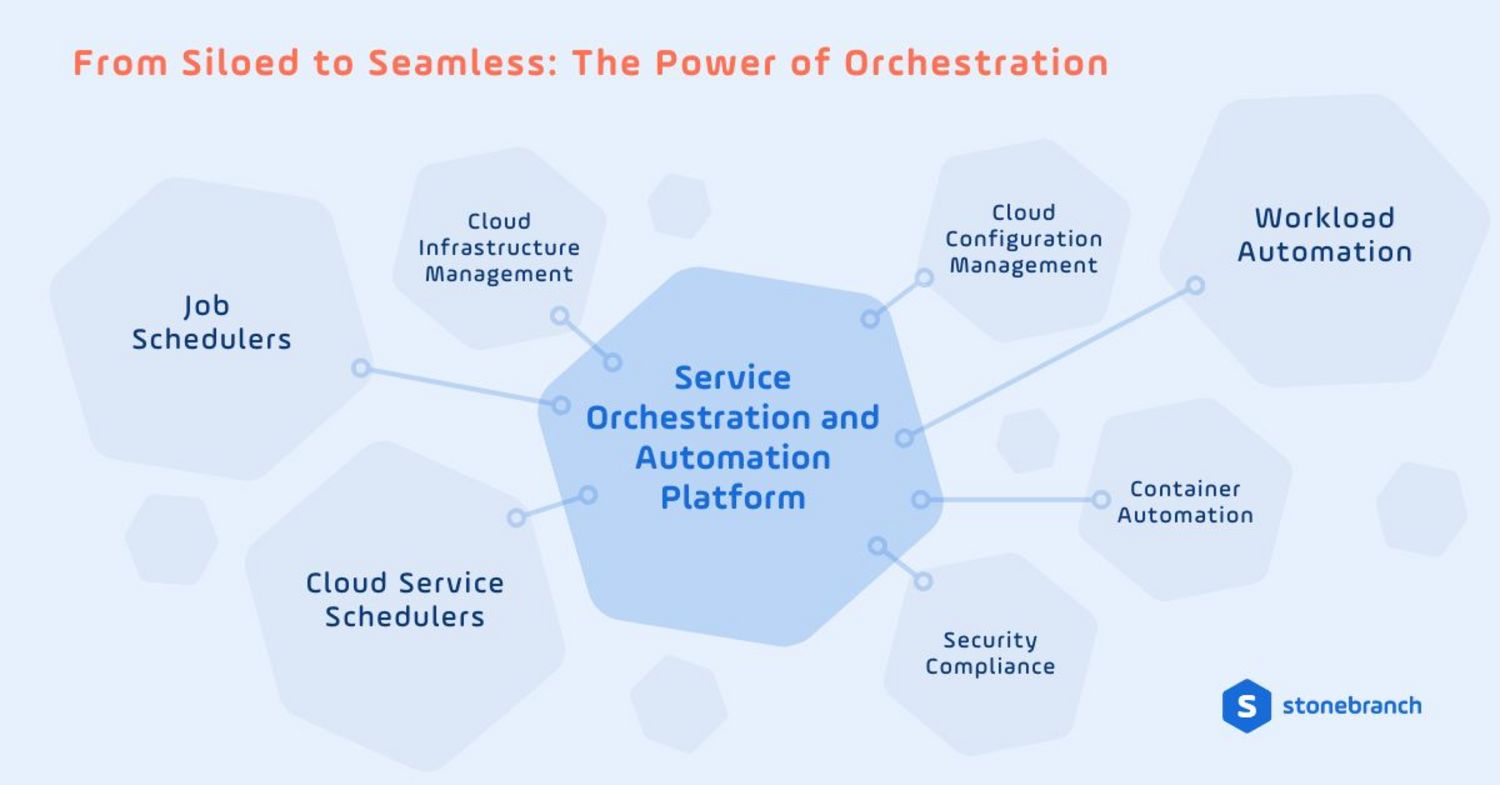
Service orchestration and automation platforms (SOAP) are ideal candidates for connecting silos of automation. By combining real-time responsiveness with unified orchestration and self-service access, SOAP empowers IT teams to modernize operations. In fact, SOAPs are specifically designed to eliminate silos and scale automation strategies that deliver business value faster.
At their core, SOAPs help companies meta-orchestrate automation across all other cloud automation tools. In other words, enterprises are enabled to centrally manage all automated processes and workflows directly from a single lens, regardless of where the automated task, or job, is actually happening.
Choosing the Right Service Orchestration and Automation Platform
The right SOAP depends on your architecture, team skillsets, and integration requirements. If you’re managing workflows across hybrid or multi-cloud environments, consider one that offers:
- Hybrid IT Support: Automates workflows that span public clouds (AWS, Microsoft Azure, Google Cloud Platform, etc.), private clouds, and on-premises systems.
- Easy Integration: Offers pre-built integrations with cloud platforms, DataOps and DevOps tools, collaboration apps, ERP systems, as well as a comprehensive software development kit (SDK) to custom-build integrations.
- Real-Time Automation: Provides event-based monitors, triggers, and webhooks driven by system events, file uploads, compliance violations, account creation, API calls, and more.
- Jobs as Code (JaC) Capabilities: Supports DevOps teams to create and manage job configurations using CI/CD methodologies, complete with version control, testing, and continuous integration.
- Infrastructure as Code (IaC) Tool: Empowers cloud operations (CloudOps) teams to provision, deploy, and manage infrastructure using declarative code — enabling version-controlled, testable, and repeatable cloud deployments that align with agile workflows.
- Low-Code and No-Code Interfaces: Features like a visual workflow designer and self-service automation portal enable non-technical users to manage their own workflows while IT Ops pros maintain governance.
- Self-Service Automation: Offers a simplified, intuitive portal that enables non-technical users to trigger and manage approved workflows without relying on IT. It should also integrate with popular collaboration and ITSM tools like ServiceNow, Jira, Microsoft Teams, and Slack to bring automation directly into the platforms teams use every day.
- Scalability: Handles any level of automation across departments, regions, systems, and projects.
- Enterprise-Wide Observability: Follows standards like OpenTelemetry to provide real-time monitoring, centralized logging, and intelligent alerting.
- Natively Integrated Managed File Transfer (MFT): Securely manages internal and external (B2B) file transfers as part of larger workflows without relying on standalone file transfer tools.
- Role-Based Access Control (RBAC): Ensures users and systems access only authorized resources based on defined roles and policies.
- Cloud Security and Compliance Features: Enforces enterprise-grade security automation capabilities with secrets management, audit trails, and built-in compliance controls aligned with industry standards.
- Reliable Vendor Support and Documentation: Backed by 24/7 expert support and a comprehensive knowledge base, as well as regular updates and an active user community.
Ready to Bring Order to Your Cloud?
Enterprises that are serious about the cloud will no doubt benefit from a cloud automation solution. Integrating and orchestrating automated workflows across a cloud ecosystem is important, but it also adds true measurable value. This value goes beyond internal process improvements. Cloud automation’s real impact lies in how you use it to drive new revenue sources.
Explore how a modern SOAP, like Stonebranch UAC, can help you orchestrate everything — from simple file transfers to complex workflows across the enterprise.
Start Your Automation Initiative Now
Schedule a Live Demo with a Stonebranch Solution Expert

